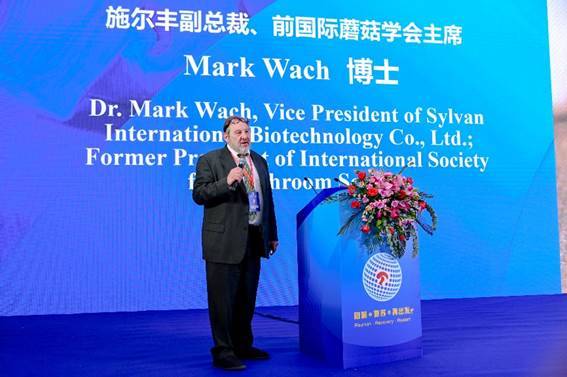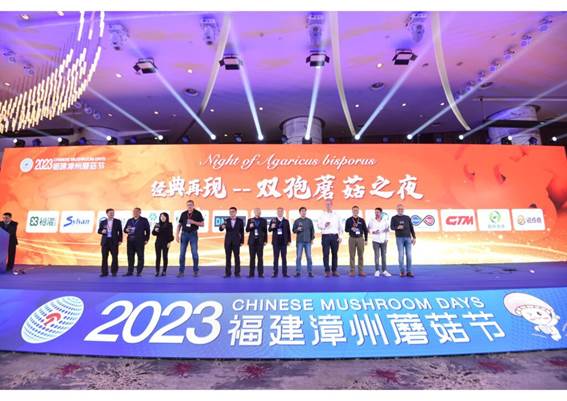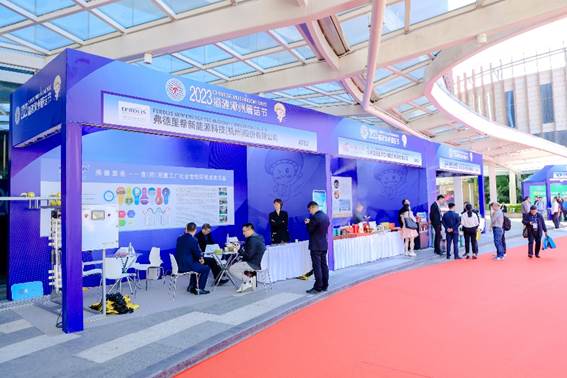By Greg Seymour, Acting Foreign Correspondent
Zhangzhou in Fujian Province
was once again the host city of Chinese Mushroom Days (CMD) on 17-19 November
2023, following a four-year hiatus due to Covid.
The weather was perfect –
warm and dry for the entire 17th edition of Chinese Mushroom Days. A new venue,
the Yuanshan Fliport Hotel, was the scene for the mushroom industry conference
and expo that is focused on the button mushroom industry and has become an icon
on the international mushroom calendar.
‘Reunion - Recovery –
Restart’ was the theme for this year’s event which had three full days of
presentations by speakers from all over the world as well as an extensive
commercial exhibition on two floors of the hotel and surrounding outdoor areas.
The organizers, CFNA,
reported 1500 delegates and 70 exhibitors attended this year’s event which was
down about 50% on the 2019 edition, the last one before Covid. While attendance
was a lower than usual, the vibe was positive with many enthusiastic personal
reconnections taking place on the commercial stands and during networking
events.

Straw as alternative substrate
After the traditional
official opening speeches, the first day’s presentations got underway with a
talk by Professor Li Yu from Jilin University on the better utilization of
straw as an alternative substrate to produce a wide range of mushroom species.
The emphasis on the need for improved environmental management could not be
missed nor the importance of the role of the mushroom industry could play in
enhanced environmental outcomes for China and the rest of the world.
Li demonstrated straw
substrates not only gave comparable production to traditional wood-based
substrates, they can significantly contribute to a better environment by
utilising vast quantities of a ‘waste product’ that is often burnt by wheat
growers.
Minimising the burning of
wheat straw after harvest reduces air pollution, CO2 emissions, and
provides an economic stimulus in regional areas by enabling another valuable
crop (mushrooms) to be produced before the straw returns to the environment via
animal feeds, a base product for the extraction of bio-compounds, or as
fertilizer/ soil amendment.

Professor Li Yu from Jilin University held a lecture on the better
utilization of straw as an alternative substrate to produce a wide range of
mushroom species
The future of casing
ISMS President Greg Seymour
was the next presenter and provided delegates with an introduction to the
recently released ‘Future of Casing’ report, and an overview of the upcoming
20th ISMS Congress and North American Mushroom Conference being held between
26-29 February in Las Vegas, USA.
Delegates learnt what was in
the “Future of Casing” report and that they could obtain a free copy of the
report from the ISMS website www.isms.biz. After sharing the key findings of
the report with delegates, Seymour shared his personal priority take-outs from
the report.
He said that it was clear
that there was sufficient deep dug wet peat available in existing licensed bogs
around Europe to supply the mushroom industry for at least the next 20-40
years. However, disruptions to peat use were likely to come from policies and
regulations adopted by governments, regulators, and retailers that prevented
peat use on a national or regional basis. Seymour highlighted the proposed
DEFRA policy on banning the use of peat in the mushroom industry in England by
2030 as an example and advised that the policy included a ban on the selling of
imported mushrooms grown on peat.
He also pointed out that
there was currently no replacement for deep dug wet peat on the horizon so
continued access to this product was essential for the economic well-being of
the industry until an economically viable 100% non-peat casing became a reality.
Consequently, the monitoring and management of the mushroom industry’s
political and operating environment will be critical to how well mushroom
groups are able to counter the impact of well-resourced and experienced
‘environmental and climate groups’ attempting to disrupt the supply and use of
peat in the mushroom industry.
World Mushroom Day?
Dr Tan Qi from the Shanghai
Academy of Agricultural Sciences was the next speaker. Dr Qi began her
presentation by recounting her recent visit to the FAO office in Rome to
advocate for an official World Mushroom Day. FAO outlined the process the
industry would need to follow, and indicated there was a good chance of success
with a well-supported and professional submission.
Dr Qi then outlined the
development and future trends in the specialty mushroom industry in China.
Already the largest producer, the current and future industrialization of
production will see China massively increase the supply of high-quality
shiitake, Pleurotus spp., morels, and many other exotic mushrooms. The
underlying challenge for producers is ensure their marketing programs are good
enough to profitably sell all their extra production.
Positive panel
The afternoon session got
underway with a panel session to discuss the question “What has happened in the
world mushroom industry?” The panel consisted of Aleksandr Khrenov (Russian
Growers Union), Jack Lemmen (GTL Europe), Ron Hegger (DMP) and Mart Christiaens
(Christiaens Group) from The Netherlands, Chris Alonzo (Pietro Industries,
USA), Sumio Ayusaw (Hokken, Japan) and Greg Seymour (ISMS).
Apart from providing their
reflections on the situation during Covid, the group was asked what they felt
about the future for the global mushroom industry. There was unanimous
agreement that the future was positive but there would be some continuing pain
for many in the industry for the next two to three years. This situation is
likely to result in some rationalization across the sector.
Interestingly, it was
reported that most growers and suppliers used the Covid period to review their
businesses. This has resulted in leaner operations and lots of innovation
industry wide so that as market conditions improve, the industry looks set for a
relatively prosperous period.

International panel
Harvesting, marketing and Poland
Jack Lemmen from GTL Europe,
based in the Netherlands, followed the panel session with an excellent presentation
on improving productivity with two-handed picking. GTL now has harvesting
systems in fourteen operations around the world where experience is
demonstrating the use of tilting or modified traditional shelving, combined
with an automated stem-cutting and mushroom packing system, makes picking up to
2.5 times faster than traditional systems. See also Mushroom Business 123 on
harvesting systems.
Jack then talked about how
to prepare farms for the future. He said the key tactic was to move
air-handling units from the front of the growing rooms to the middle to free-up
the working corridor for the installation of a mezzanine floor. Harvesters would
still access rooms from the ground floor while the mezzanine floor would
utilized for packing etc.
Tomasz Kuczmaszewski from
Sylvan Australia was the next speaker. Tom provided delegates with an overview
of the Australian mushroom industry and the efforts of its generic marketing
program to increase mushroom consumption. Hanna Zielinska from Okechamp in
Poland was up next and introduced her company’s vertically integrated
operations before providing a brief overview of the mushroom industry situation
in Poland.
Spawn
The last four speakers of
the day gave presentations on various aspects of edible mushroom spawn. First
up, Professor Zhang Jinxia from the Chinese Academy of Agricultural Sciences in
Beijing provided delegates with a picture of developments in fungal spawn in
China. Next, Dr Mark Wach from Sylvan International gave a presentation on
trends and developments in the global spawn business using some highlights from
Sylvan’s spawn research program.
Importantly, Mark said that
the systems that Sylvan had successfully developed for Agaricus breeding and
development were highly applicable to other exotic varieties such as Shiitake
and Plurotis spp. Results from early work on these specialty mushrooms
indicates there will be significant gains in their commercial quality and
productivity performance over the next few years.

Dr Mark Wach from Sylvan International
Mr Eiichi Kimura from the
Kinokkusu company in Japan then provided delegates with an insightful overview
of the present situation and future challenges confronting the edible mushroom
industry in Japan. The final speaker for the day was Dr Ji Junxia from Lambert
spawn who gave an overview of the specialty mushroom market in North America
and the advantages of Lambert’s SI product.
Night of Agaricus bisporus
The Button Mushroom Night
dinner followed the first day’s presentations. There was an exciting vibe in
the air as many delegates had the chance to catch up on four years of
separation over a few wines and bijous (Chinese vodka). The buffet provided a
great meal while the crowd was entertained by some excellent live music. The
traditional acknowledgement of sponsors took place on stage with many
well-known international identities participating in a mass ‘ganbei’
(bottoms-up toast)!
Interestingly, a video
presentation by Fuyang City and Funan Country of Anhui Province on a major
vertically integrated mushroom development currently under construction got
proceedings underway. The sheer scale and complex planning of the initiative
was mind-boggling. It is likely that many similar government-funded mushroom
developments of this scale will occur in the foreseeable future as the
government seeks to diversify the economy, spread wealth, stimulate economic
growth, and look after the environment - particularly in regional areas.

Sponsors on stage at the Night of Agaricus bisporus
Tradefair
The Expo was made up of the
usual major international players from Europe and North America, like Hoving,
Christiaens Group and DMP, but Chinese international and domestic businesses
provided the bulk of the exhibitors. Delegate interest in the products and
services on display in the 70 exhibition booths was high. Detailed discussions
between exhibitors and potential customers were observed on many stands and
sitting areas throughout the event.
Specialty mushrooms
The second day’s program
focused on specialty mushrooms. The morning got underway with a review and
discussion of current and future production systems. This was followed by a
session on the equipment available to support the various systems and mushroom
types.
The afternoon program began
with speakers talking on recent developments in the cultivation of morels (Morchella
spp.) and black boletes (Phlebopus portentosus). This was followed with
a series of presentations on the status of international markets for specialty
mushrooms.
The final session consisted
of a panel discussion looking at issues associated with China’s specialty
mushroom industry going global. The day concluded with a Specialty Mushrooms
dinner where guests were treated to a traditional Chinese banquet. The lively
networking continued from the night before with a great deal of fervour.
The Day 3 program got
underway with presentations on straw utilization for mushroom production
followed a panel session on the topic. The morning session concluded with
presentations on the review and discussion of production technology development
for the Wine Cap mushroom (Stropharia rugosoannulata), the cracking
Shiitake (Lentinula edodes), and the Bamboo or Wedding Veil mushroom (Dictyophora
rubrovolvata).
The final session of the
event provided a series of presentations and a panel session on the culinary
aspects of edible mushrooms. Several of the speakers focused on developments in
the ‘food service’ and ‘prepared dishes’ market segments while the panel
discussed where the whole market was heading and where opportunities might lie.

Expo Stands outside the hotel.
Conclusion
Overall, the organizers can
be well pleased with the 17th edition of Chinese Mushroom Days, the first since
2019 when Covid intervened. On all counts CMD 2023 was a success for delegates,
exhibitors and sponsors. With next year’s event back at its traditional venue
and likely to attract a bigger audience as the world progresses to a ‘new
Normal’, its easy to understand why Chinese Mushroom Days is such an important
event for the global mushroom industry.
After many farewells and
promises to catch-up in Las Vegas for the ISMS Congress and North American
Mushroom Conference, it was time for many international guests to head for
Xiamen airport to board flights for all parts of the globe or stay-on in China to
travel to mushroom destinations across the country.
Copyright ?
Mushroom Business 2023, first published in Mushroom Business no. 122.
Republished with permission by the publisher Global Roel Media
BV. www.mushroombusiness.com